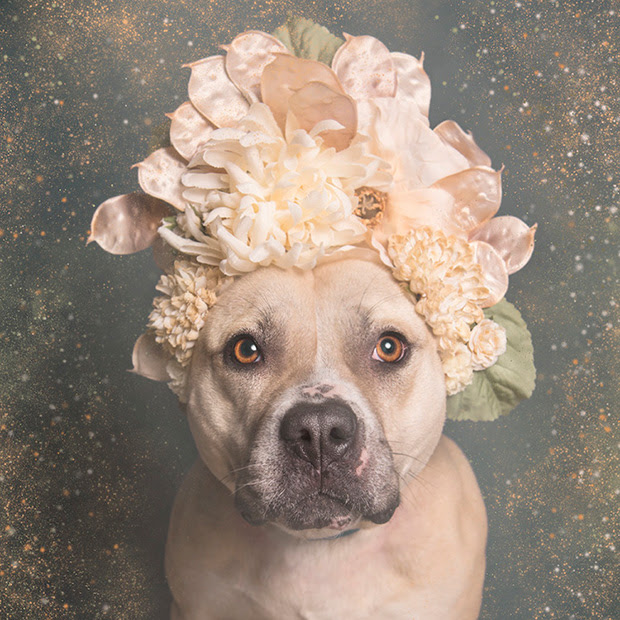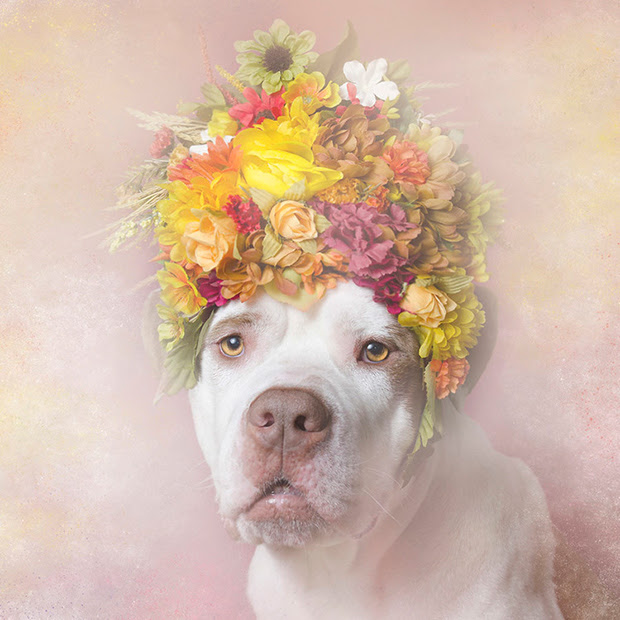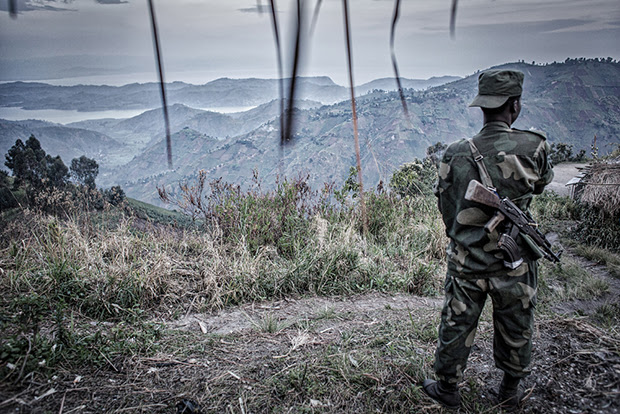Feature Shoot |
|
Posted: 17 Sep 2015 05:00 AM PDT
 Murdock, available for adoption at Last Hope Animal Rescue  Aphrodite, available for adoption at Sean Casey Animal Rescue  Apple, adopted Murdock, says New York-based photographer Sophie Gamand, who has been making portraits of pit bull type dogs over the last year, is “the sweetest dog.” Like many pit bulls who ultimately wind up homeless and in shelters, Murdock was abused at a dog fighting ring, where he was used as a “bait dog” to test the fighting strength of other dogs. His mouth was likely taped shut so that he was unable to defend himself, and he survived the ordeal with one blind eye and numerous wounds. Despite the cruelty of his past, Murdock was and continues to be deeply loved by the shelter staffers who care for him. Pit bulls like Murdock are what drives Gamand to continue to fight against the stigma that often surrounds them with her series Pit Bull Flower Power, for which she has photographed over one hundred dogs cloaked in handmade crowns of blossoms. Although the rosy images certainly inspire smiles, Gamand stresses that their message is a serious one. Because of both the stereotypes surrounding pit bulls and the fact that they are often bred and then discarded by careless owners, dogs who fall into the broad category of “pit bull type dogs” account for an astonishing percentage of homeless animals. More than one million pit bull type dogs are put to sleep each year, and only one in six hundred finds a forever home. In the United States, notes the photographer, a pit bull is euthanized approximately every thirty seconds. In her own words, it’s “the quiet massacre.” All the dogs in Flower Power were photographed in shelters and rescues, and the flower crowns, which the photographer makes herself, harken back to Late Baroque painting. They’re symbolic, she explains, of the vulnerability of the animals and of the poignancy of their current situations. “It’s about what was lost,” says the artist. But what’s lost can also be found. These dogs, many of them fearful but all of them tender-hearted, are waiting for their second chance. Portraits from Flower Power, in some cases, have directly led to adoptions and forever homes for their subjects. For all the ways in which mankind has wronged pit bulls, we can make amends. Gamand stressed the importance of spaying and neutering all dogs and of choosing adoption over shopping for dogs; no dog, she suggests, can be judged based on the way he or she looks. When she began the project, she experienced her own doubts about being around pit bulls, but seeing them for herself has undone years of bad press. After eight months of being confined to a cage and kept as evidence in an ongoing court case against his owner, Murdock was finally allowed outside to play, and since that day, he has been showering all he meets with kisses and affection. What makes pit bulls special, notes Gamand, is their loyal and loving disposition and their “achingly human” faces; she adds that as social and active creatures, “they are not meant to be locked up in a cage all day long.” Today, Gamand opens her Flower Power exhibition at Gallery Adrien / Kavachnina in Paris, where pit bulls are banned and police are able to confiscate dogs who have the look of a pit bull. The Flower Power initiative, notes the photographer, “is not just about pit bulls, it’s also about our humanity and what we do to animals.” Dogs like Murdock, she says, deserve to know what it means to be loved. Sophie Gamand celebrates the opening of her exhibition tonight at 6 PM, and the show will run until October 12th. Many of the dogs featured in Flower Power, including Adrienne, who is a part of our Flora and Fauna show at Photoville, and Murdock, who is still available for adoption at Last Hope Animal Rescue and Rehabilitation. He can also be tracked via the Adopt Murdock Facebook page. Adrienne, Murdock, and others in Flower Power were photographed at the Town of Hempstead animal shelter. Please consider adopting or donating to Hempstead, Last Hope, or a shelter of your choosing. Flower Power calendars, prints, and other products are available for purchase, and Gamand regularly updates her Instagram with information about the project and the dogs via the #PitBullFlowerPower campaign. Gamand has also developed a set of tips for photographing shelter animals; a great photo, she says, often leads to a forever home. Find them here.  Aria, adopted  Baby, adopted  Bertha Bean, adopted  Blossom, available for adoption at Brookhaven Animal Shelter  Kahula, adopted  Lola, adopted  Mr. Fantastic, adopted All images © Sophie Gamand The post Homeless Pit Bulls Get a Chance to Shine in Floral Photo Series appeared first on Feature Shoot. |
|
Posted: 16 Sep 2015 07:00 AM PDT
  War for Minerals is photographer Erberto Zani‘s visual investigation of the men who mine for coltan, manganese, and other rare metals in the Democratic Republic of Congo, often under unclear, dangerous, and complicated political conditions. Coltan and Manganese, for example, are rare metals used to make mobile phones and computers whose market value has skyrocketed, thus attracting both the interest of multinational corporations and criminal organizations. While these men mine for said minerals, often barefoot and without unionized support of any kind, these corporations have concurrently engaged in buying off local armed rebel groups to fight off the interest of other armed rebel factions in an effort to take control of the mining industry. Legal? No. Complicated? Yes. Especially when, according to Zani, we learn that Rwandan buyers, soldiers, and police are also involved. The mining occurs in front of a backdrop of an ongoing rebel movement, formed mostly by “Congolese Hutu” some of whom have been “reintegrated into the Congolese army.” Zani, who has worked on similar mining issues in Colombia and India, is currently looking to publish this work under the title “Black World,” along with this collection of images taken in the DR of Congo during the conflict between the national army (FARDC) and the M23, a rebel group in the eastern part of the country, that has resulted in a high number of civilian casualties. We spoke with Zani further about his experience with illegal mining on a global scale and how this work came to be.      What made you want to investigate this issue further? “All my work as a photographer is focused basically on social documentary topics, including this body of work. My goal is to investigate, via photo and interviews, what happens inside the mines (to expose the inhumane conditions), to find out who’s controlling the labor, and the reasons behind the demands of these minerals, etc. Usually I work, as much as possible, “inside” the story: near the protagonist/the miners. In this way, I try to feel their physical and mental suffering.”  Where are most of these miners from and what does the daily life look like? What role do children have in this work, if at all? “The men are from the North Kivu region, especially near the town of Rubaya, where they find “jobs” in Mudere’s mine. Here, they are under the control of the Nyatura militia, an ally of the FARDC. “There is no such thing as “training” for this “job” — people start digging and carry out what they are told to: looking for minerals. Via interviews with different people (military, miners, civil people in Rubaya and Goma) I learned the route of these minerals of war (coltan, manganite, gold, diamonds…) are from the D.R.Congo to Rwanda, where they receive a certificate as “Rwandan” and become free to sell all over the world. “When I went inside the mine, there weren’t any children at work; the soldiers probably hid them beforehand. I asked people in the village of Rubaya and they told me that there are a lot of children who stay in the mine, especially during the rainy season. Tunnel digging is incredibly dangerous and, in general, most soldiers prefer prefer to use small children because they can make and fit into smaller holes.”   Are there any local NGO’s on the ground there? Is there anybody advocating for these men often put in dangerous work environments? “There are no NGO’s in the area. Usually no foreigners are allowed to travel near the mines. With the war going on, the numerous armed gangs are a nightmare for anyone. Here the price for a life is very low, corruption is as endemic as the malaria, and the people live day by day in terror.”   The post A Look Inside the Illegal Mining Industry in the Democratic Republic of Congo appeared first onFeature Shoot. |
